Explore Nha Trang - Central Vietnam Travel, Asia
Nestled along the beautiful coast of Vietnam, Nha Trang stands out as a top destination for travelers. This coastal city, known for its gorgeous beaches and teeming marine life, caters to everyone. Nha Trang welcomes you with open arms, whether you're seeking adventures, culture, or relaxation by the sea. This guide will take you through the highlights of this stunning locale, making your travel planning seamless and exciting.
Population: Approximately 423,000 in 2019.
Economy: One of Vietnam’s most important tourist hubs and the largest economy of Khanh Hoa Province.
Landmarks: Famous for the Po Nagar Cham Towers, Nha Trang Cathedral, and Hon Mun Island.
Vietnam

Overview of Nha Trang
History & Cultural Influence
Nha Trang’s history is as rich and diverse as its landscape. Originally a part of the Champa Kingdom, the city bears the marks of Cham culture, visible in the ancient Po Nagar Cham Towers. These towers, dating back to the 7th century, stand as a testament to the city's historical roots.
In the 19th century, French colonial influence reshaped Nha Trang, introducing architectural styles that blend seamlessly with the local aesthetics. Landmarks such as the Nha Trang Cathedral, with its French Gothic design, and the Long Son Pagoda, offer a glimpse into the city’s storied past. Exploring these sites, you'll feel the layers of history that have shaped Nha Trang into the vibrant city it is today.
Interaction with the Locals
Nha Trang, a vibrant coastal city in Vietnam, has a population of approximately 535,000 residents. Known for its lively atmosphere and warm hospitality, the city is a melting pot of cultures and traditions. The population is a mix of local Vietnamese, with influences from Cham heritage, and a growing number of expatriates and tourists who are drawn to its beautiful beaches and dynamic lifestyle. This diversified population adds to the city's vibrant cultural tapestry and friendly atmosphere.
Meet the friendly Vietnamese and learn more about the unique culture with our premium tours to Vietnam here.
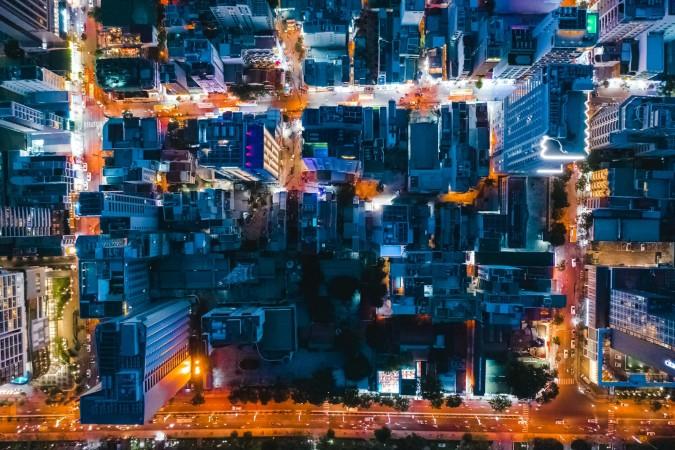
Modern Nha Trang at night - © Krisztian Tabori
Top Attractions in Nha Trang
Nha Trang is brimming with attractions that cater to a wide range of interests. Here are some must-see spots:
- Vinpearl Land: Located on Hon Tre Island, Vinpearl Land is an amusement park and resort complex offering a plethora of activities. From thrilling rides to a sprawling water park, it's a perfect destination for families and adventure enthusiasts.
- Po Nagar Cham Towers: These ancient towers are a must-visit attraction in Nha Trang for history buffs. Standing majestically on a hill overlooking the Cai River, Po Nagar Cham Towers provide a glimpse into the spiritual life of the Cham people.
- Long Son Pagoda: Famous for its giant white Buddha statue, Long Son Pagoda is both a spiritual and visual delight. The pagoda, located at the foot of Trai Thuy Hill, is adorned with intricate mosaics and offers a peaceful retreat from the bustling city.
- Nha Trang Cathedral: Built during the French colonial era, Nha Trang Cathedral is a striking example of Gothic architecture. Its impressive facade and tranquil interior make it a serene spot for reflection and a key landmark in the city.
- Hon Mun Island: For those who love diving and snorkeling, Hon Mun Island is a paradise. The island is part of a marine protected area and boasts vibrant coral reefs and diverse marine life. Clear waters and colorful corals make it an ideal spot for underwater exploration.
- Nha Trang Institute of Oceanography: Founded in 1922, the Institute of Oceanography is a fascinating place for anyone interested in marine science. The institute houses an impressive collection of marine specimens, including rare and endangered species, making it an educational stop for all ages.
Nha Trang is a coastal city that has plenty of attractions to bring memorable experiences for travellers. If you love to visit coastal cities, check out our article about Da Nang here.
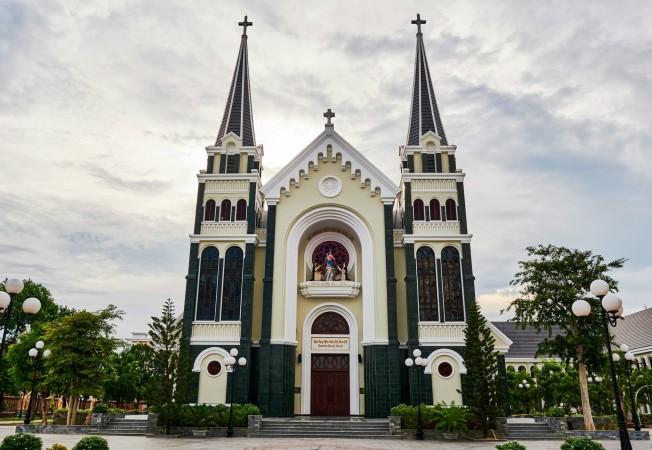
Nha Trang Cathedral - © Duy Viec
Must-Try Dishes in Nha Trang
Nha Trang's culinary scene is a delightful mix of fresh seafood and traditional Vietnamese flavors. Similar to other regions across Vietnam, Nha Trang dishes focus on freshness and delicacy.
- Bun Cha Ca: Bun Cha Ca is a local dish made with grilled fish cakes, vermicelli noodles, fresh herbs, and a delicious broth. The dish is often garnished with green onions and chili, offering a perfect balance of savory and spicy flavors.
- Nem Nuong Ninh Hoa: Nem Nuong Ninh Hoa is a popular dish consisting of grilled pork skewers served with rice paper, fresh vegetables, and a variety of dipping sauces. The smokey, sweet, and tangy tastes make it popular with both residents and visitors.
- Banh Canh Cha Ca: This hearty soup features thick noodles, fish cakes, and a savory broth made from pork bones and fish. Often garnished with cilantro, green onions, and a squeeze of lime, Banh Canh Cha Ca is a comforting and satisfying meal.
- Banh Xeo: Banh Xeo are crispy Vietnamese pancakes filled with shrimp, pork, bean sprouts, and green onions. Served with fresh lettuce and herbs, these savory pancakes are enjoyed by wrapping them in rice paper and dipping them in a tangy sauce.
- Bun Sua: Bun Sua is a unique Nha Trang delicacy made with jellyfish. The dish consists of vermicelli noodles topped with crunchy jellyfish, peanuts, and herbs, all brought together with a light and flavorful broth. It's a cool meal ideal for a hot day.
- Goi Ca Mai: Goi Ca Mai is a raw fish salad popular in Nha Trang. Thinly sliced fish is marinated in lime juice and mixed with a variety of herbs, peanuts, and a tangy dressing. This results in a crisp and zesty meal that emphasizes the freshness of the local fish.
- Banh Can: Banh Can are small rice flour pancakes cooked in special clay molds. These bite-sized treats are typically topped with quail eggs, shrimp, or squid and served with a side of dipping sauce and fresh vegetables. They are a popular street food and a must-try for visitors.
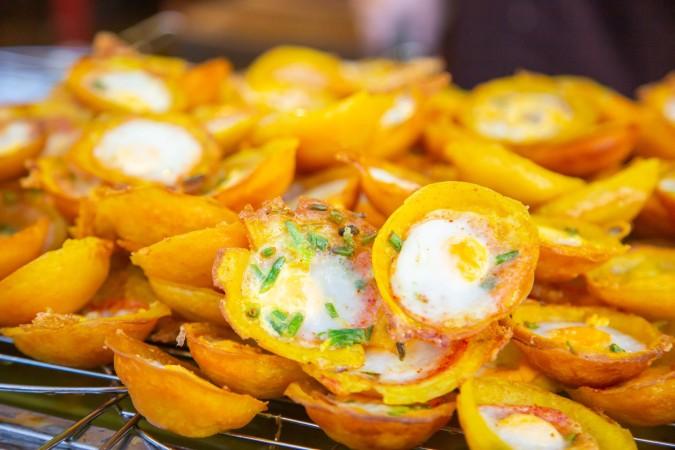
Banh Can Nha Trang - © Helio Center
Festivals & Local Celebrations
Nha Trang hosts several vibrant festivals and local celebrations that showcase its rich cultural heritage and lively spirit:
- Sea Festival: The Sea Festival, held every two years, is one of Nha Trang's most significant events. It features a week-long celebration of the city's maritime culture with activities such as boat races, seafood feasts, and cultural performances. The festival attracts visitors from all over the world and provides a fantastic opportunity to experience local traditions.
- Ponagar Tower Festival: This annual festival takes place at the Po Nagar Cham Towers, honoring the goddess Po Nagar. Traditional Cham dances, music performances, and religious ceremonies will be featured at the occasion. It's a fascinating glimpse into the spiritual life and cultural practices of the Cham people.
- Whale Worshiping Festival: Held in honor of the whale, considered a sacred animal by local fishermen, this festival includes processions, offerings, and prayers for a bountiful fishing season. It’s a unique Nha Trang cultural event that highlights the close relationship between the locals and the sea.
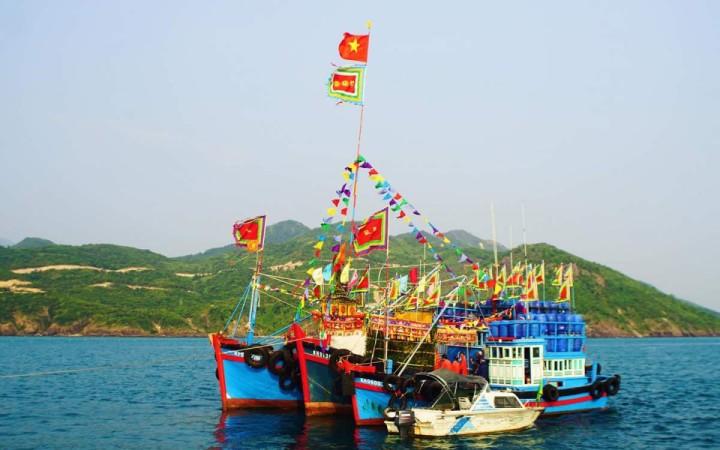
Whale Worshiping Festival - © MIA
Weather in Nha Trang: Best Time to Visit
Nha Trang enjoys a tropical savanna climate, making it a year-round destination for travelers. However, understanding the weather conditions and tourism trends can help you plan the best time for your visit:
Dry Season in Nha Trang
The dry season is the peak tourism period in Nha Trang, with warm temperatures ranging from 25°C to 35°C (77°F to 95°F). This season attracts the most visitors due to its sunny and dry weather, ideal for beach activities, island hopping, and exploring outdoor attractions. The sea is quiet and clear, ideal for snorkeling and diving. Popular events like the Nha Trang Sea Festival often occur during this period, adding to the vibrant atmosphere. Hotels and resorts can be more expensive and crowded, so booking in advance is recommended.
Crowded Season in Nha Trang
The shoulder season is an excellent time to visit for those looking to enjoy the good weather without the peak season crowds. Temperatures remain warm, and there are plenty of sunny days. It's a great time for sightseeing, enjoying water sports, and exploring local markets. Accommodation prices may be more reasonable, and attractions less crowded, providing a more relaxed experience.
Rainy Season in Nha Trang
The rainy season sees more frequent showers and occasional storms, with temperatures slightly cooler, averaging between 23°C and 30°C (73°F to 86°F). Although the rain can be heavy at times, it often occurs in short bursts, leaving plenty of time for indoor activities like visiting museums, temples, and local markets. This season attracts fewer tourists, making it a great time for budget travelers seeking lower accommodation rates and a quieter experience. Special deals and discounts are often available during this period.
Off-Peak Season in Nha Trang
During the off-peak season, the city experiences the heaviest rainfall and fewer tourists. While outdoor activities may be limited, this is an ideal time for those looking for a peaceful getaway. Enjoy cultural experiences, such as cooking classes and local craft workshops, without the crowds. The beaches and attractions are less crowded, providing a more serene environment. Travelers during this time can take advantage of the lowest prices for hotels and services.
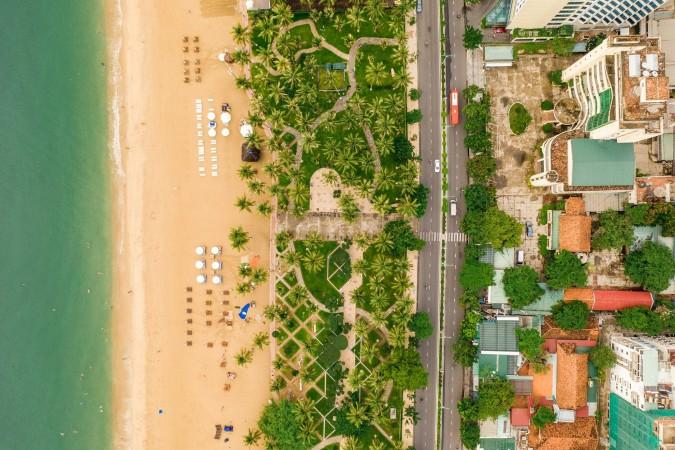
Nha Trang Off-Peak Season - © Krisztian Tabori
What to Do in Nha Trang
Nha Trang offers a wide range of activities that cater to different interests and provide unforgettable experiences:
- Snorkeling and Diving: The clear waters of Nha Trang are perfect for snorkeling and diving. Sites like Hon Mun Island and the Nha Trang Bay Marine Protected Area are renowned for their vibrant coral reefs and diverse marine life. Both novice and experienced divers can discover the underwater treasures.
- Island Hopping: Nha Trang is surrounded by beautiful islands such as Hon Tam, Hon Mun, and Hon Tre. Each island offers unique attractions, from luxury resorts to pristine beaches and adventure activities. Island hopping tours are a great way to explore these scenic spots.
- Mud Baths: For a relaxing experience, visit the famous Thap Ba Hot Springs or I-Resort. These spas offer therapeutic mud baths and mineral water treatments, believed to rejuvenate the skin and promote relaxation.
- Water Sports: Nha Trang's coastline is ideal for a variety of water sports, including jet skiing, parasailing, and kayaking. The warm waters and steady waves make it a popular destination for both beginners and experienced water sports enthusiasts.
Enjoy underwater activities? Check out our article about Ha Long here, where you can explore more things you can do while travelling to Vietnam
Shopping in Nha Trang
Nha Trang's shopping scene is diverse, offering everything from local handicrafts to modern fashion:
- Dam Market: Dam Market is one of the largest and most popular markets in Nha Trang. Here, you can find a wide array of goods, including fresh produce, seafood, clothing, and souvenirs. It's a bustling spot where you can experience the local culture and practice your bargaining skills.
- Nha Trang Night Market: Open every evening, the Nha Trang Night Market is a vibrant place to shop for souvenirs, local crafts, and street food. The market is filled with stalls selling jewelry, clothing, and handmade goods. It’s also a great place to sample local snacks and dishes.
- Vincom Plaza: For a more modern shopping experience, visit Vincom Plaza. This shopping mall offers a variety of international and local brands, a supermarket, and numerous dining options. It's a convenient spot for finding quality products and enjoying some leisure time.

Snorkeling in Nha Trang - © Betty Sun
Cultural Etiquette in Nha Trang
Respecting local customs and manners when visiting Nha Trang will improve your experience and demonstrate your admiration for Vietnamese culture. Here’s a guide to help you navigate social interactions gracefully:
- Greetings: In Nha Trang, a friendly smile and a polite nod are commonly used as greetings. For more formal interactions, a slight bow with hands pressed together in front of you is traditional, though handshakes are also common, especially in urban settings. Always address the group's elders first.
- Dress Code: Dress modestly when visiting religious sites and temples. Covering your shoulders and knees is respectful and appropriate. While casual clothing is fine for most other settings, it's a good idea to dress neatly and comfortably, especially when dining in higher-end establishments.
- Dining Etiquette: When dining, wait to be seated by the host and begin eating only after the eldest person at the table starts. Use chopsticks properly and avoid placing them upright in a bowl of rice, as this mimics the incense sticks used at funerals. It’s also courteous to finish all the food on your plate and avoid excessive noise while eating.
- Respect for Elders: Showing respect for elders is an important cultural value in Nha Trang. Allow elders to speak first, offer them the best seat at the table, and address them with appropriate titles. Small gestures of respect, like standing when an elder enters the room, are highly appreciated.
- Public Behavior: Public displays of affection are generally reserved, so it’s best to keep personal interactions discreet. Speaking loudly or arguing in public can be seen as disrespectful. Maintain a calm and polite demeanor in all public interactions.
- Tipping: Tipping is not a traditional practice in Vietnam, although it is becoming increasingly popular in tourist destinations. A small tip for excellent service in restaurants or hotels is a nice gesture, but not obligatory.
- Photography: Always ask for permission before taking photos of people, especially in rural areas or during religious ceremonies. Respect any signs indicating no photography and be considerate of people’s privacy.

Salt-making in Nha Trang - © Quang Nguyen Vinh
Essential Travel Information
Getting Around Nha Trang
Navigating Nha Trang is very simple, with a variety of transit alternatives to meet different preferences:
- Taxis and Ride-Hailing Services: Taxis are widely available and reasonably priced. Reliable companies include Mai Linh and Vinasun. Ride-hailing apps like Grab offer convenient and often cheaper alternatives.
- Motorbike Rentals: Renting a motorbike is a popular way to explore the city and surrounding areas. It's an affordable and flexible option, but ensure you have a valid license and wear a helmet at all times.
- Buses: Nha Trang has a network of local buses that connect major attractions and neighborhoods. The buses are an economical option, though they can be less convenient due to fixed routes and schedules.
- Bicycle Rentals: For a leisurely way to explore the coastal areas and quieter streets, renting a bicycle is a great option. Many hotels and guesthouses provide bicycle rentals for their customers.
- Boats and Ferries: To visit nearby islands, regular boat and ferry services are available from Nha Trang Port. These services range from public ferries to private speedboat charters, catering to different budgets and preferences.
ATM & Banking Services
Nha Trang offers ample banking facilities and ATMs for easy access to cash and financial services. ATMs are widely available throughout the city, particularly in tourist areas, with major banks accepting international cards. For currency exchange, it's best to use Vietnamese banks which offer better rates and security compared to hotels and licensed counters. Credit cards are broadly accepted in hotels, restaurants, and larger stores, but carrying some cash is advisable for small purchases and places that do not accept cards.
Where to Stay in Nha Trang
Nha Trang offers a diverse range of accommodation to fit different budgets and preferences. Luxury travelers can indulge in high-end resorts which feature world-class amenities, private beaches, and top-notch service. Mid-range options offer comfort and convenience with features like swimming pools, fitness centers, and on-site dining. Budget travelers can choose from hostels and guesthouses, which still provide basic amenities plus a friendly atmosphere and are closer to local life. For a more authentic experience, homestays offer a chance to immerse yourself in local culture by staying with Vietnamese families.
Articles for you

Explore Yala National Park - Sri Lanka Travel, Asia
Tucked away in Sri Lanka’s southeastern corner, Yala National Park is where wild nature meets deep tradition. Known worldwide for its leopard population, the park is also home to elephants, sloth bears, crocodiles, and hundreds of bird species. Beyond wildlife, Yala opens doors to a cultural landscape dotted with ancient temples, Buddhist ruins, and coastal villages. For travelers seeking more than just a safari, Yala offers a chance to explore eco-tourism, local communities, and sacred heritage sites.
Population: The Yala National Park area doesn’t have a human population.
Economy: The economy around Yala National Park thrives on a blend of eco-tourism, agriculture, and local services. Safari tours, eco-lodges, and cultural experiences drive steady income for nearby towns like Tissamaharama and Kataragama, supporting thousands of families.
Landmarks: Famous for Block I of Yala and wildlife encounters, including elephants, sloth bears, crocodiles, and exotic bird species.

Explore Galle - Sri Lanka Travel, Asia
Nestled on Sri Lanka’s southern coastline, Galle is a vibrant city where history meets the sea. Its cobbled streets, colonial architecture, and serene beaches make it a must-visit destination for travelers seeking a blend of culture, adventure, and relaxation. A UNESCO World Heritage site, Galle captivates visitors with its Dutch Fort, bustling markets, and friendly locals. Whether you’re exploring the ramparts at sunset or savoring fresh seafood by the shore, Galle promises an unforgettable journey into Sri Lanka’s heritage.
Population: Approximately 113,000 in 2023.
Economy: Galle’s economy thrives on tourism, trade, and fisheries. The city’s historic fort, colonial architecture, and coastal charm draw thousands of international visitors each year, making tourism its main economic driver. Fishing remains vital for local livelihoods, supplying fresh seafood across the region.
Landmarks: Famous for the Galle Fort, Dutch Reformed Church & Maritime Museum, and Unawatuna Beach.

Explore Bentota - Sri Lanka Travel, Asia
Nestled along Sri Lanka’s southwestern coast, Bentota is a tropical paradise that blends golden beaches, vibrant culture, and thrilling adventures. Famous for its calm waters, luxury resorts, and scenic river estuary, Bentota has become a top destination for travelers seeking both relaxation and authentic experiences. From serene beach walks at sunrise to adrenaline-pumping water sports, this coastal town offers a perfect balance of leisure and exploration. With its proximity to Colombo and Galle, Bentota is easy to reach, making it an ideal stop for both short escapes and extended holidays.
Population: Approximately 37,000 in 2023.
Economy: Bentota’s economy thrives mainly on tourism, which drives local businesses such as hotels, restaurants, and wellness retreats. The town also benefits from fishing, coconut cultivation, and handicrafts like wood carving and batik textiles. Many residents rely on the growing demand for water sports and Ayurvedic treatments, making tourism the backbone of both income and employment in the area.
Landmarks: Famous for Bentota Beach, Bentota River Safari, and Kande Vihara Temple.

Explore Mirissa - Sri Lanka Travel, Asia
Mirissa is a charming coastal town on Sri Lanka’s southern shoreline. Known for its golden beaches, turquoise waters, and vibrant marine life, it has become a must-visit stop for travelers exploring the island. Many come for whale watching, surfing, and sunset views at Coconut Tree Hill, but Mirissa offers much more than postcard beauty. The fishing boats you see anchored by the bay carry generations of stories. Local traditions, delicious cuisine, and a laid-back rhythm of life shape every visitor’s experience.
Population: Approximately 4,700 in 2023.
Economy: Mirissa’s economy is largely shaped by its coastal location. Fishing has long been the backbone of local livelihoods, with generations relying on the Indian Ocean for income. In recent decades, tourism has become the main driver of growth, thanks to whale watching, surfing, and beachside hospitality.
Landmarks: Famous for Mirissa Beach, Coconut Tree Hill, and Parrot Rock Bridge.

Explore Nuwara Eliya - Sri Lanka Travel, Asia
Tucked away in the Central Highlands of Sri Lanka, Nuwara Eliya is often called “Little England”. With its rolling tea plantations, cool misty mornings, and colonial charm, this mountain town feels like a step into another world. Travelers come here to breathe fresh air, walk through flower gardens, sip the finest Ceylon Tea, and enjoy a pace of life far from the island’s busy cities. Whether you’re drawn by scenic landscapes, heritage architecture, or the warmth of its people, Nuwara Eliya is a destination that blends nature, culture, and history in perfect harmony.
Population: Approximately 781,000 in 2023.
Economy: Nuwara Eliya’s economy thrives mainly on tea production, as it sits in the heart of Sri Lanka’s central highlands, famous worldwide for Ceylon Tea. The city also benefits from a growing tourism industry, attracting visitors with its colonial charm, cool climate, and scenic landscapes.
Landmarks: Famous for Gregory Lake, Hakgala Botanical Garden, and Victoria Park.

Explore Sukau - Malaysia Travel, Asia
Nestled on the banks of the Kinabatangan River in Sabah, Malaysian Borneo, Sukau is a destination where wildlife, culture, and conservation come together. Known as one of Asia’s top spots for river safaris and eco-tourism, this quiet village offers a front-row seat to encounters with Bornean orangutans, pygmy elephants, proboscis monkeys, and exotic birdlife.
Population: Approximately 1,400 in 2019.
Economy: Sukau’s economy is shaped by its riverine location and natural resources. Traditionally, the Orang Sungai community relied on fishing, small-scale farming, and forest gathering for their livelihood. Today, the village has shifted toward eco-tourism, with river cruises, jungle trekking, and homestays providing income.
Landmarks: Famous for the Kinabatangan River cruises, Gomantong Caves, and Ox-bow lakes and wetlands.
